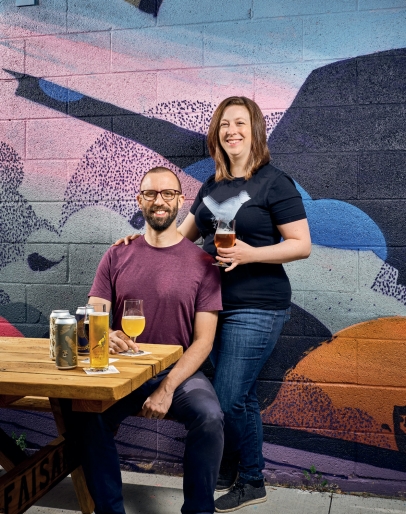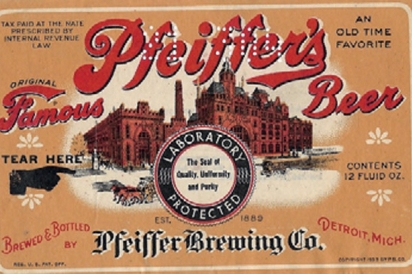Brewery Faisan Takes Flight
Paul and Rachel Szlaga had their craft microbrewery and taproom open only four months when the pandemic shut it down.
Still, their story of how they made Brewery Faisan a reality almost reads like a motivational poster with words like persistence, patience and perseverance coming to mind, especially with finding the location.
“Everything lined up for us, which was wild,” says Rachel Szlaga. “If it takes years, it’s worth it.”
It all began when the young couple won first place at Kuhnhenn Brewing’s annual chili cook-off. The prize: a home brewing kit.
“We both kind of nerded out and got into it,” recalls Paul Szlaga, with a laugh.
And then some. That was before the Wayne State University alumni— she went for her bachelor’s in arts and he pursued his master’s in engineering—were even married. Never in their wildest dreams did they imagine a decade later they’d be opening a Belgian-style microbrewery in Detroit’s Islandview neighborhood.
Eventually, though, the idea came to them. Rachel Szlaga reasoned that the same dedication she practiced in “tedious artmaking”— as she jokingly refers to her chosen medium—would surely help the pair successfully navigate starting a business. That and a fair share of pragmatism, adds Paul Szlaga: “We shadowed a few commercial brewers and realized this was something we could probably do.”
While he kept his “day job” as a wastewater civil engineering consultant, Rachel Szlaga took a small-business course at the Build Institute, an easy walk from their Corktown home, and soon became obsessed with searching through real estate. It took four years and several deals falling through to find the right building, which they did in 2016: a 1950s brick-facade-over-cinder-block warehouse that once housed lumber and later rigging cranes. To the Szlagas, its high ceilings were perfect for installing 15-barrel stainless steel brewing equipment.
“We had a checklist and this building had everything we were looking for,” says Paul Szlaga, including being located on a block that was zoned industrial.
“That was important to us. We always viewed brewing as an industrial endeavor,” adds Rachel Szlaga. Motor City Match awarded the pair a $60,000 grant to cover architectural drawings. Finding used equipment was similarly fortuitous. “Eventually the fantasy became more and more real.”
The Islandview location—near Belle Isle, between Lafayette Park and West Village—felt right too, because of its beer-making heritage. Pfeiffer Brewing Co. operated only blocks away on the same street from 1934 until 1962.
The Szlagas went to work renovating the 6,000-square-foot main building (another 3,000-square-foot back building remains ready for future endeavors), maintaining its warehouse vibe and keeping the brewery equipment largely on display. What they could, they did themselves, from pouring the concrete for the top of the bar and tiling its front to milling their own barley.
“Body by barley,” jokes Paul Szlaga, comparing his frequent hefting of 50-pound bags to a fitness regimen.
Rachel Szlaga found a slew of mid-century modern chairs to go with tables their friend Wayne Maki of Mutual Adoration built from repurposed Packard Plant flooring. In a nice twist, Maki’s wedding to Clare Fox—the two also own home goods store POST Detroit— ended up being the debut event for the new brewery’s beer.
Belgian-style beers, like Faisan’s, stand apart from other styles because they tend to be much drier than standard beers Americans may be accustomed to drinking. The Belgian yeast’s characteristics highlight a certain fruitiness and nuttiness.
“It’s a really unique yeast that generally gives off very specific esters,” says Rachel Szlaga.
“They’re a little more subtle, so you have to be more careful about what flavors you incorporate,” says Paul Szlaga, adding that Faisan sticks with traditional methods instead of following beer-making trends. To help the uninitiated become more familiar, Faisan offers 6-ounce “half pours” along with standard 12- or 16-ounce full pours, from carefully considered glassware.
“We try to find stemware that complements the beer style,” says Paul Szlaga, explaining why they use stemware for the Belgians, rather than the more common pint. “I think it’s better for beer. You have a slightly tapered top. You can smell the beer. It’s one of our lofty goals. We want beer to be elevated the way wine might be.”
“You want those [aromas] to collect in the glass,” he adds, “like a snifter. You appreciate it more.”
To accommodate those who can’t quite shake their love of IPAs, Faisan also makes a variety of IPAs, lagers and a Kolsch. And Belgian- style or not, Faisan rotates some of the offerings to highlight seasonal flavors including a cranberry cardamom wit called Axiom or others featuring apricot, tarragon and lemon peel. A bestseller is Periphery, a raspberry saison.
“We wanted a big menu so people who aren’t yet in love with Belgians had options,” says Paul Szlaga.
What you won’t find on the menu is food.
“We want to be known for the beer. I tell people ‘I could make you food, but you wouldn’t like it,’” says Rachel Szlaga, with a laugh. But that doesn’t mean that you can’t order food to be delivered or time a visit for when they have a food truck or pop-up on-site. One couple recently bicycled there and unpacked a picnic to enjoy with their beer at one of the patio tables, not far from the mural by French graffiti artist Rensone—who even incorporated the logo—painted just before the pandemic shut everything down. The taproom has become a popular spot for cyclists to visit.
“We seem really remote, but we’re actually close to so much,” says Paul Szlaga.
“We call it ‘up north in the city,’” adds Rachel Szlaga. “It’s super peaceful over here.”
Brewery Faisan Taproom, 1087 Beaufait St., Detroit; 313- 290-2987. Visit breweryfaisan.com.
DETROIT’S BREWING HISTORY
Part of what makes their Islandview location so special to the founders of Brewery Faisan is the Detroit neighborhood’s beer-making history.
Pfeiffer Brewing Company, at one point Michigan’s largest brewery, was located just about a mile down Beaufait from Brewery Faisan. A part of the large complex still stands not far from Mack.
“They’re kind of surrounded by it. It’s kind of a good mix of beer and auto history,” says Steve Johnson, author of Detroit Beer, a History of Brewing in the Motor City. He points out that Regal Brewing was only a street or two away too.
“In Michigan, we have a lot of diversity in beer,” says Johnson, who appreciates Brewery Faisan’s embrace of traditional Belgian-style beer making. For some monasteries in Belgium, the Belgian style is “all they’ve done for 300 years, but in America, that’s not how we do things. We change things around. I think it’s great that’s [Brewery Faisan’s] approach with what they do in Detroit.”
A portion of Johnson’s own personal label collection is featured in the Detroit Historical Museum’s exhibition Detroit’s Brewing Heritage, on display through the end of the year. The exhibition traces the history of Detroit beer from the 1800s “all the way to the dynamic brewing town we’ve become and where we’re headed,” says Tracy Irwin, chief exhibitions and enrichment officer of the Detroit Historical Society.
Learn more about the exhibit at detroithistorical.org.
DETROIT’S CHINESE RING-NECKED PHEASANTS
“When we bought the building there were pheasants across the street,” says Paul Szlaga about the former rail-line-turned-prairie-like-vacant land across the street. One even roosted on the microbrewery’s roof. Faisan, the French word for pheasant, fit the bill for the microbrewery’s name. Having the word brewery precede it is a nod to European brewery names.
“It’s cool how that one bird has inspired so much of Detroit,” says Rachel Szlaga.
This wild game bird’s time in Detroit (and Southeastern Michigan) dates back to the start of the 1900s when the city’s many small farms provided a suitable habitat with plenty of livestock grains and tall grasses to eat and train line tree rows providing shelter. In later years, the city’s vacant properties and green spaces continued to supply insects and vegetation to sustain Detroit’s unofficial mascot. While they can fly—even reaching speeds up to 60 mph—pheasants are most often spotted running swiftly through lots and darting across streets.
“There is this culture of pheasants in Detroit, where people make paintings and murals and name their soccer teams—or breweries— after pheasants,” says Diane Weiss, who interviewed the Szlagas as part of the still-in-production short documentary Pheasants of Detroit she’s making with director Diane Cheklich. “The first time you see a pheasant in Detroit you ask ‘What’s that?’ It’s just a unique thing to have in a major metropolitan city.”
Find @pheasantsofdetroit on Instagram or Facebook.








